|
Impressionism in a Nutshell
by Bob Brooke
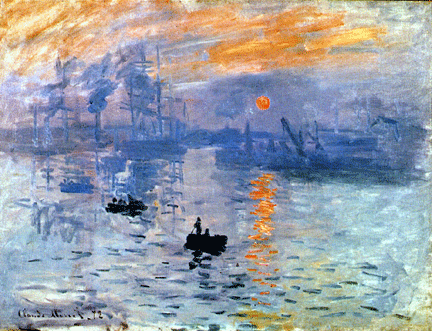 Impressionism
was a 19th-century art movement that began as a loose association of
Paris-based artists exhibiting their art publicly in the 1860s. Its name
derived from the title of a Claude Monet work, Impression, Sunrise,
which provoked the critic Louis Leroy to coin the term in a satiric
review published in Le Charivari. Impressionism
was a 19th-century art movement that began as a loose association of
Paris-based artists exhibiting their art publicly in the 1860s. Its name
derived from the title of a Claude Monet work, Impression, Sunrise,
which provoked the critic Louis Leroy to coin the term in a satiric
review published in Le Charivari.
The Batignolles district of Paris, where many avante-garde artists and
writers lived, was the epicenter of this new artistic movement. Painter
Edouard Manet presided over evening gatherings at the local Café
Guerbois.
Le Salon
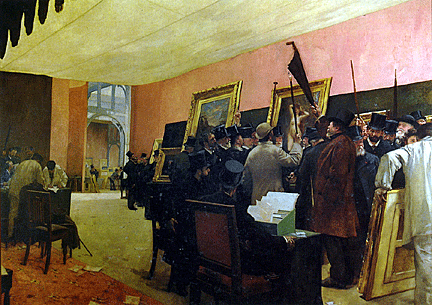 At
the time in Paris, the Académie des Beaux-Arts—commonly known as Le
Salon--dominated the French art scene in the mid 19th century. The
Académie was the upholder of traditional standards for French painting,
both in content and style. At
the time in Paris, the Académie des Beaux-Arts—commonly known as Le
Salon--dominated the French art scene in the mid 19th century. The
Académie was the upholder of traditional standards for French painting,
both in content and style.
It's members valued historical subjects, religious themes, and
portraits, but not landscape and still life. They also preferred
carefully finished images which mirrored reality when examined closely.
In 1863, Emperor Napoleon III decreed that the public be allowed to
judge the works themselves and commanded that the Académie organize Le
Salon des Refusés or The Salon of the Refused.
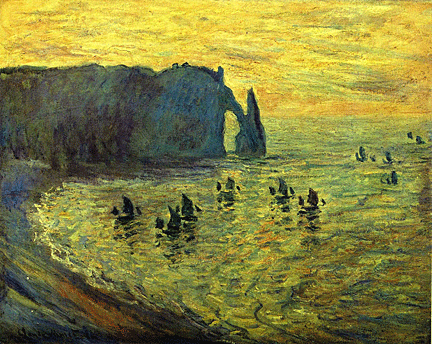 Late
in 1873, Monet, Renoir, Pissarro, and Sisley organized Le Société
Anonyme Coopérative des Artistes Peintres, Sculpteurs, Graveurs, the
"Cooperative and Anonymous Association of Painters, Sculptors, and
Engravers," so they could exhibit their works independently. Late
in 1873, Monet, Renoir, Pissarro, and Sisley organized Le Société
Anonyme Coopérative des Artistes Peintres, Sculpteurs, Graveurs, the
"Cooperative and Anonymous Association of Painters, Sculptors, and
Engravers," so they could exhibit their works independently.
Critics had a mixed response to the Exhibit of 1874. Art critic Leroy
Louis declared that Monet's painting--The Cliff at Étretat after the
Storm (1885)—could hardly be called a finished work. Even though
Impression, itself, gained acceptance in Le Salon by the 1890s, the
artists, themselves, saw little financial reward from their exhibitions.
Edouard Manet, despite his role as a leader to the group, never
abandoned his liberal use of black as a color and never participated in
the eight Impressionist exhibitions.
Common Characteristics of Impressionist
Works
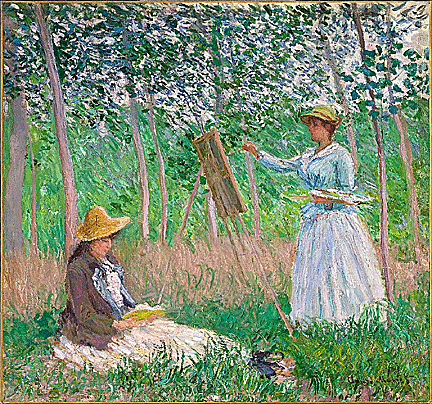 The
Impressionists discovered that they could capture the momentary and
transient effects of sunlight by painting en plein air. Working in the
open air focused the Impressionists' interest on the fleeting effects of
light and colors of nature, which could only be captured in the
shorthand technique than the laborious process of academic art. Painting
realistic scenes of modern life, they emphasized vivid overall effects
rather than details. The
Impressionists discovered that they could capture the momentary and
transient effects of sunlight by painting en plein air. Working in the
open air focused the Impressionists' interest on the fleeting effects of
light and colors of nature, which could only be captured in the
shorthand technique than the laborious process of academic art. Painting
realistic scenes of modern life, they emphasized vivid overall effects
rather than details.
Encompassing a different way of seeing, Impressionism was an art of
immediacy and movement, candid poses and compositions, and the play of
light expressed in a bright and varied use of color. Radicals in their
time, early Impressionists broke the rules of academic painting by
giving colors, freely brushed, primacy over line. They used short,
"broken" brush strokes of pure and unmixed color, not smoothly blended,
as was customary, in order to achieve the effect of intense color
vibration.
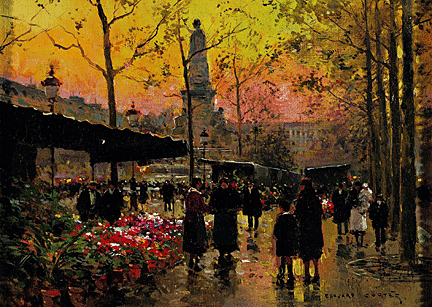 The
Impressionists used color boldly, focusing on the primary colors—red,
yellow, and blue—plus white to create their paintings. They took
advantage of the mid-19th-century introduction of premixed paints in
lead tubes, resembling modern toothpaste tubes, which allowed artists to
work more spontaneously, both outdoors and indoors. The
Impressionists used color boldly, focusing on the primary colors—red,
yellow, and blue—plus white to create their paintings. They took
advantage of the mid-19th-century introduction of premixed paints in
lead tubes, resembling modern toothpaste tubes, which allowed artists to
work more spontaneously, both outdoors and indoors.
They used short, thick strokes of paint to quickly capture the essence
of a subject, rather than its details, often applying paint impasto.
Impressionist painters applied colors side-by-side with as little mixing
as possible, creating a vibrant surface. The optical mixing of colors
occurs in the eye of the viewer rather than in the paint surface,
itself.
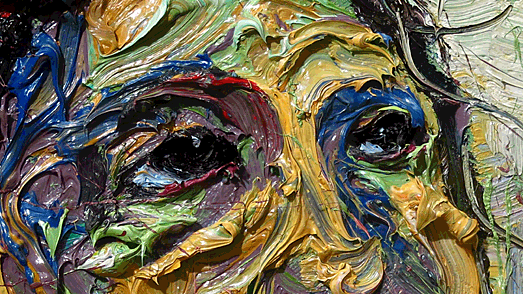
Painters produced grays and dark tones by mixing complementary colors
such as red and green and avoided using black. They placed wet paint
into wet paint without waiting for successive applications to dry,
producing softer edges and an intermingling of color, unlike traditional
in traditional painting where artists used underpainting and thin glazes
to achieve the results they wanted. The surface of an Impressionist
painting is typically opaque.
Landscapes
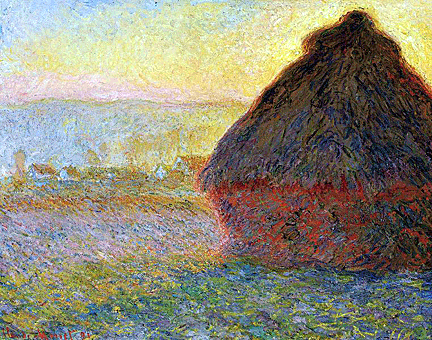 Some
of the Impressionist painters loved to go out in the fresh air and
sunshine to paint the landscapes and seascapes around them. When
painting landscapes, they focused on color and light. Some
of the Impressionist painters loved to go out in the fresh air and
sunshine to paint the landscapes and seascapes around them. When
painting landscapes, they focused on color and light.
Many Impressionists painted in the evening to get effets de soir—the
shadowy effects of the light in the evening or twilight. They emphasized
the play of natural light, paying close attention to the reflection of
colors from object to object.
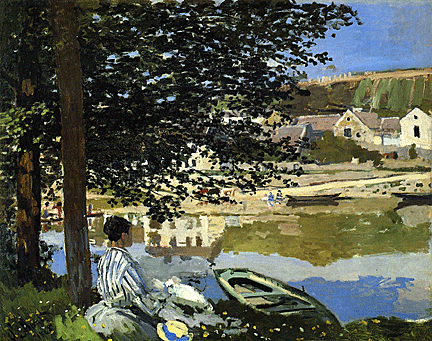 In
paintings made en plein air, they boldly painted shadows with the blue
of the sky as it reflected onto surfaces, giving a sense of freshness
and openness that traditional painters failed to capture. By painting
the scene as they saw it outdoors, the Impressionists gave a freshness
to their works that hadn't been seen before. In
paintings made en plein air, they boldly painted shadows with the blue
of the sky as it reflected onto surfaces, giving a sense of freshness
and openness that traditional painters failed to capture. By painting
the scene as they saw it outdoors, the Impressionists gave a freshness
to their works that hadn't been seen before.
Impressionist landscape painters sought to express their perceptions of
nature, rather than create exacting reflections or mirror images of the
world.
The Impressionists relaxed the boundary between subject and background
so that the effect of an Impressionist painting often resembles a
snapshot, a part of a larger reality captured as if by chance. Japanese
art prints, which had originally come into France as wrapping paper for
imported goods, contributed significantly to the "snapshot" angles and
unconventional compositions which became characteristic of the
Impressionists.
Artists focused on the one thing they could inevitably do better than
the photograph— capture an image subjectively.
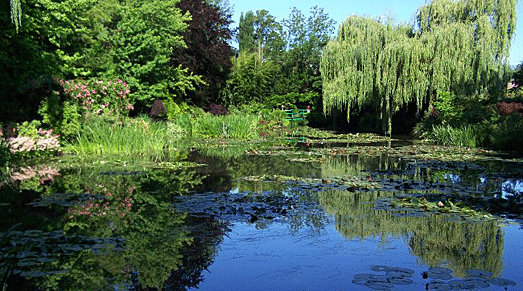
Claude Monet's work clearly represents the aims of Impressionism. He was
dedicated to painting in the open air—to capturing nature by
observation. The gardens of the Impressionists often appear in their
paintings. Monet's second love, after his painting, was his garden in
Giverny. Monet is most noted for his series of paintings of the water
lilies in his garden.
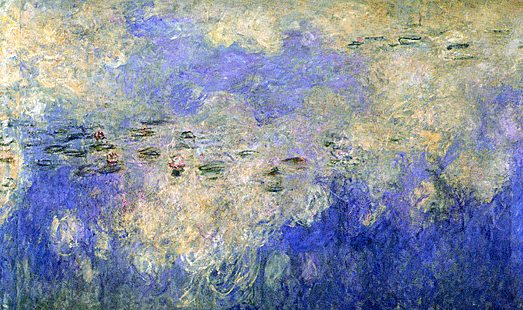
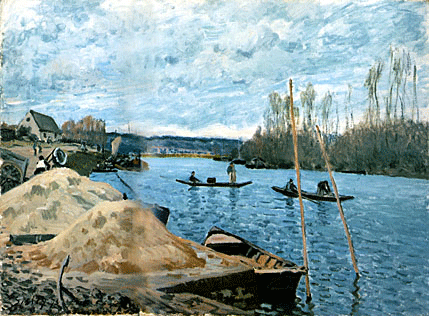 He
also painted a series of haystacks in different light at different times
of the year and often made a study in light of favorite landscapes and
buildings. He
also painted a series of haystacks in different light at different times
of the year and often made a study in light of favorite landscapes and
buildings.
Alfred Sisley's art focused on the riverside villages to the west of
Paris. He favored capturing images of the Seine as it meandered through
the countryside. Painting bourgeois men and women idling their days away
among flower beds didn't appeal to Emile Pissarro. He'd rather paint the
local peasants working in vegetable patches and fields near his home in
Pontoise. He loved painting people whose lives were tied to the soil.
Paintings of Modern Life
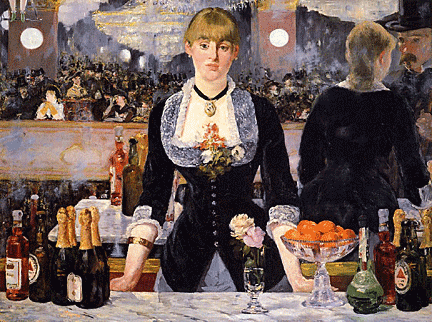 Using
the snapshot technique, Edouard Manet often cropped off figures at the
edge of his paintings to make them seem like a slice of life that seems
to continue beyond the frame. Using
the snapshot technique, Edouard Manet often cropped off figures at the
edge of his paintings to make them seem like a slice of life that seems
to continue beyond the frame.
In the 1870s Paris was the theatrical capital of Europe. People crowded
the opera houses and café-theaters nightly. Most had rows of boxes
called loges.
Modern Paris was a city of cafés and restaurants whose terraces spilled
out onto the pavement. This dynamic café life inspired many
Impressionist images. The Impressionists participated in Paris' new café
life and at the same time observed it. Initially, they gathered to
discuss their creative ideas at the Café Guerbois.
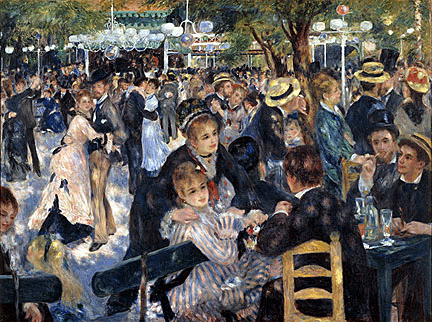 Prior
to the Impressionists, other painters, such as 17th-century Dutch
painters, had focused on common subjects, but they employed traditional
composition, arranging their compositions so the main subject commanded
the viewer's attention. Prior
to the Impressionists, other painters, such as 17th-century Dutch
painters, had focused on common subjects, but they employed traditional
composition, arranging their compositions so the main subject commanded
the viewer's attention.
Auguste Renoir loved to paint people. He was a fine draughtsman and
captured the life and enthusiasm of his subjects. He combined
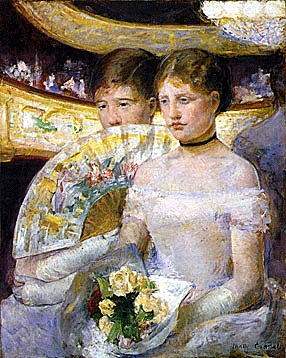 his
interest in painting outdoors with depicting modern life and people in
pictures of Parisians enjoying weekends in the country. his
interest in painting outdoors with depicting modern life and people in
pictures of Parisians enjoying weekends in the country.
Renoir loved the challenge of capturing a large group of people in a
variety of poses.
His expertise and artistic craftsmanship shows in his relaxed paintings
of people having a good time. He also fantasized about working women and
showed them in all their voluptuousness in his works.
Critics called the fluent delicacy and rapid, sketchy brushstrokes of
Berthe Morisot slapdash. But her subtle colors show off the elegant
bourgeois women she painted.
While Mary Cassatt, an American painter who joined the Impressionist
Movement, painted the social and private lives of women.
The Influence of Photography
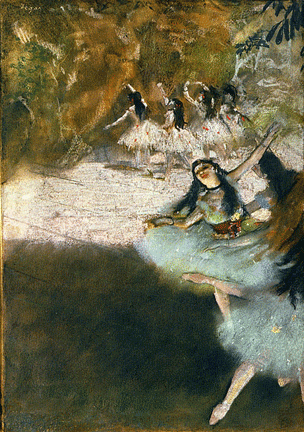 Photography
inspired Impressionists to capture the moment, not only in the fleeting
lights of a landscape, but in the day-to-day lives of people. The new
medium of photography also encouraged Impressionist painters to exploit
color, which photography then lacked. Photography
inspired Impressionists to capture the moment, not only in the fleeting
lights of a landscape, but in the day-to-day lives of people. The new
medium of photography also encouraged Impressionist painters to exploit
color, which photography then lacked.
Photography heavily influenced Edgar Degas who captured ballet dancers
in almost snapshot-like poses. He was also intrigued by the social world
backstage. Unlike many of the other Impressionists, Degas loved to
create structured compositions into which he would breathe life.
Degas also loved to make preliminary sketches in charcoal or pastel and
then assemble his compositions in his studio. Many called Degas a
painter of dancers. But he said that for him painting dancers was a
pretext for painting beautiful fabrics and rendering movement.
Post Impressionism
From the 1880s onward, several artists—Vincent van Gogh, Paul Gauguin,
Georges Seurat, Cezanne, and Henri de Toulouse-Lautrec— began to develop
different precepts for the use of color, pattern, form, and line,
derived from the Impressionist. They became known as Post
Impressionists.
<
More Special Features
Next Article > |
